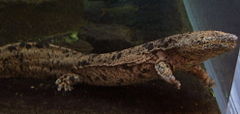- Giant salamander
-
Giant Salamanders 
Andrias japonicus Scientific classification Kingdom: Animalia Phylum: Chordata Class: Amphibia Subclass: Lissamphibia Order: Caudata Suborder: Cryptobranchoidea Family: Cryptobranchidae
Fitzinger, 1826Genera Andrias
CryptobranchusThe hellbender and Asian giant salamanders (family Cryptobranchidae) are aquatic amphibians found in brooks and ponds in the United States, China, and Japan. They are the largest living amphibians known today. The Japanese giant salamander (Andrias japonicus), for example, reaches up to 1.44 metres (4.7 ft), feeds on fish and crustaceans, and has been known to live for more than 50 years in captivity.[1] The Chinese giant salamander (Andrias davidianus) can reach a length of 1.8 metres (5.9 ft).[2]
Contents
Etymology
The family name is from the Ancient Greek krypto ("hidden"), and branch ("lung"). This is a reference to how the members absorb oxygen — through capillaries of their side-frills.
Physical description and feeding
Cryptobranchids are large, corpulent salamanders, with large folds of skin along their flanks. These help increase the animal's surface area, allowing them to absorb more oxygen from the water. They have four toes on the forelimbs, and five on the hind limbs. Their metamorphosis from the larval stage is incomplete, so that the adults retain gill slits (although they also have lungs), and lack eyelids. They can reach a static size of 2 meters (6 feet 6 inches) in length. They weigh up to 145 lbs. Chinese Giant Salamanders have lived as long as 75 years in captivity. The Chinese giant salamander eats aquatic insects, fish, frogs and also crabs and shrimps. [3]
They hunt mainly at night, and as they have poor eyesight, they use sensory nodes on their head and body to detect minute changes in water pressure, allowing them to detect their prey.[4]
Reproduction
During mating season, the salamanders will travel upstream, where the female lays two strings of over two hundred eggs each. The male fertilizes the eggs externally by releasing his sperm onto them, and will then guard them for at least three months, until they hatch.[3] At this point, the larvae will live off their noticeable stored fat until ready to hunt. Once ready they will hunt as a group rather than individually.
Scientists at Hiroshima City Asa Zoological Park in Japan have recently discovered that the male salamander will spawn with more than one female in his den. On occasion the male "den master" will also allow a second male into the den; the reason for this is unclear.
Taxonomy
Family Cryptobranchidae
- Genus Cryptobranchus (hellbender)
- Hellbender (Cryptobranchus alleganiensis )
- Genus Andrias (Asian giant salamanders; sometimes classified among the Cryptobranchus)
- Chinese giant salamander (Andrias davidianus) – (Simplified Chinese: 娃娃鱼; pinyin: wāwāyú)
- Japanese giant salamander (Andrias japonicus) – (Japanese: オオサンショウウオ)
- †Andrias scheuchzeri
- Genus Aviturus
- (Aviturus exsecratus )
- Genus Zaissanurus
- (Zaissanurus beliajevae ).
Fossil history
In 1726, the Swiss physician Johann Jakob Scheuchzer described a fossil as Homo diluvii testis (Latin: Evidence of a diluvian human), believing it to be the remains of a human being that drowned in the biblical Deluge. The Teylers Museum in Haarlem, Netherlands bought the fossil in 1802, where it still is being exhibited. In 1812, the fossil was examined by Georges Cuvier, who recognized it as not being human. After being recognized as a salamander, it was renamed Salamandra scheuchzeri by Holl in 1831. The genus Andrias was only coined six years later by Tschudi. In doing so both the genus, Andrias (which means image of man), and the specific name, scheuchzeri, ended up honouring Scheuchzer and his beliefs. It and the extant A. davidianus cannot be mutually diagnosed, and the latter, only described in 1871, is therefore sometimes considered a synonym of the former.[5]
Natural habitat
In Japan their natural habitat is threatened by the creation of dams. Ramps and staircases have been added to some dams to allow them to move upstream to areas that they spawn. [6]
Cultural references
Andrias scheuchzeri plays a major role in Karel Čapek's novel War with the Newts. A giant salamander is in nearly every episode of Pani Poni Dash!.
In Okayama Japan the locals have parades and celebrate these creatures.[6]
References
- ^ AmphibiaWeb - Andrias japonicus
- ^ AmphibiaWeb - Andrias davidianus
- ^ a b Lanza, B., Vanni, S., & Nistri, A. (1998). Cogger, H.G. & Zweifel, R.G.. ed. Encyclopedia of Reptiles and Amphibians. San Diego: Academic Press. pp. 69. ISBN 0-12-178560-2.
- ^ Earth's Endangered - Chinese Giant Salamander Facts
- ^ Amphibian Species of the World 5.1. Genus Andrias. Accessed 2008-04-10.
- ^ a b National Geographic coverage
External links
- BBC article with video on Giant salamanders from Japan
- Cryptobranchid Interest Group
- Tree of Life: Cryptobranchidae
- Chinese Giant Salamander
- Japanese Giant Salamander
Caudate families by suborder Kingdom Animalia · Phylum Chordata · Subphylum Craniata · Superclass Tetrapoda · Class Amphibia Cryptobranchoidea Cryptobranchidae · Hynobiidae
Salamandroidea Sirenoidea SirenidaeCategories:- Cryptobranchoidea
- Cryptobranchidae
- Genus Cryptobranchus (hellbender)
Wikimedia Foundation. 2010.

